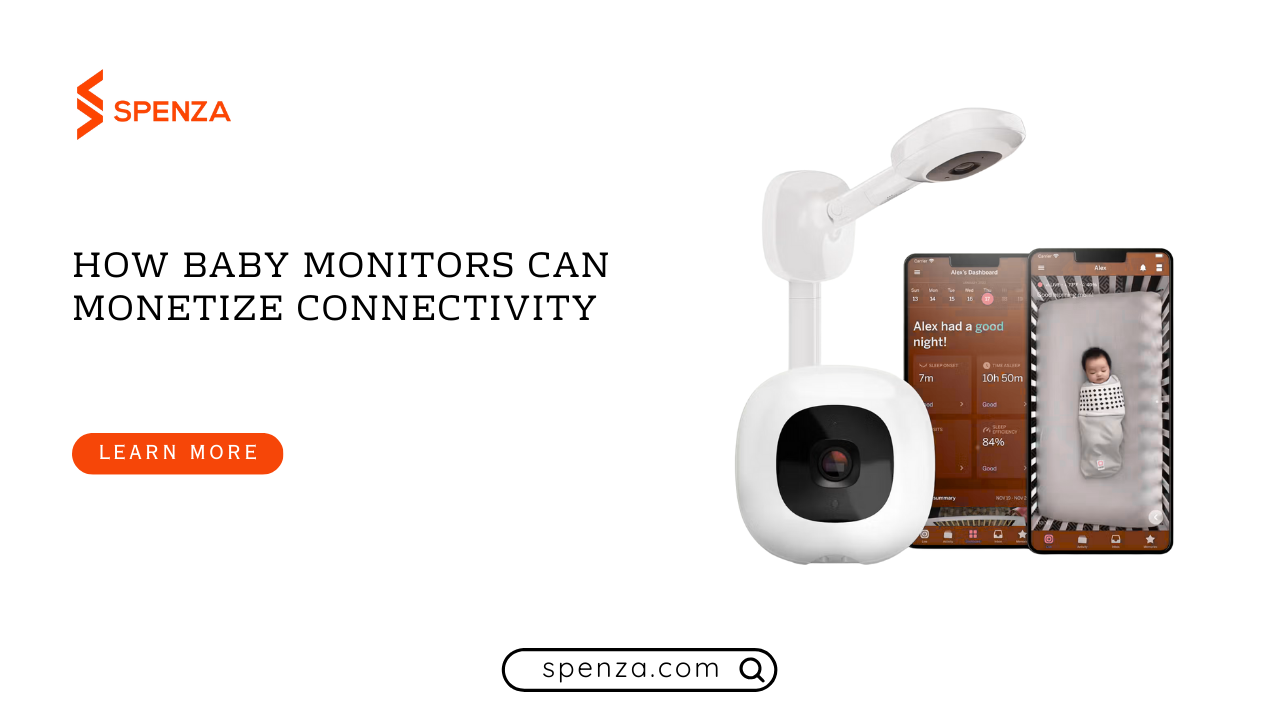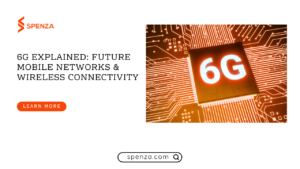TL;DR / At-a-Glance Summary
Wi-Fi Dependence Causes Failure
Home Wi-Fi is unstable and creates outages that parents blame on the monitor, leading to bad reviews and high support costs.
Cellular = Guaranteed Uptime
Embedding multi-carrier eSIM keeps monitors online at all times through automatic failover, creating real peace of mind.
Sell Reliability, Not Just Charts
Parents will pay subscriptions for guaranteed connectivity (safety), whereas "sleep insights" often see high churn.
Audio-First Keeps Costs Low
Low-bitrate audio plus periodic snapshots ensures safety during Wi-Fi drops without expensive video streaming costs.
Spenza Enables Fast Cellular Launch for OEMs
Spenza allow OEMs to launch cellular monitoring immediately, handling billing, eSIM management, and compliance without the need to build a telecom stack.

Why Baby Monitoring Needs Cellular Connectivity
Every premium smart baby monitor, from Nanit to Owlet to Miku, relies on one invisible element: your customer’s home Wi-Fi. That dependency is also your greatest vulnerability. When a router reboots at 3:00 AM or household interference disrupts the 2.4GHz signal, a $300 device suddenly becomes a “paperweight” to a sleep-deprived parent.
These moments are not minor technical hiccups. They are failures of the product’s core promise, and they drive support costs, negative reviews, and churn.
Now imagine transforming this weakness into your strongest source of recurring revenue. By embedding multi-carrier cellular connectivity, you stop selling only hardware and begin offering guaranteed, always-on baby monitoring that parents trust. Connectivity becomes the product.
Subscriptions become the backbone of high-margin, predictable revenue. And parents willingly pay for this upgrade because they are paying for peace of mind, not another set of charts.
1–2 star reviews mentioning “connectivity issues” account for over 60% of negative feedback across leading smart baby monitors. For many customers, Wi-Fi failure is perceived as product failure, not network failure.
This guide provides a practical playbook for executives, product leaders, and CTOs who want to evolve from “camera plus app plus insights” to a cellular-backed monitoring service that never goes offline. You will learn how to convert fragile Wi-Fi dependence into a scalable subscription business that funds long-term growth and product differentiation.
The Hidden Weakness in Every Baby Monitor: Home Wi-Fi
Modern smart baby monitors look like sophisticated IoT devices, but they still compete for space on the same overcrowded 2.4 GHz band as microwaves, Zigbee hubs, Bluetooth devices, and budget routers.
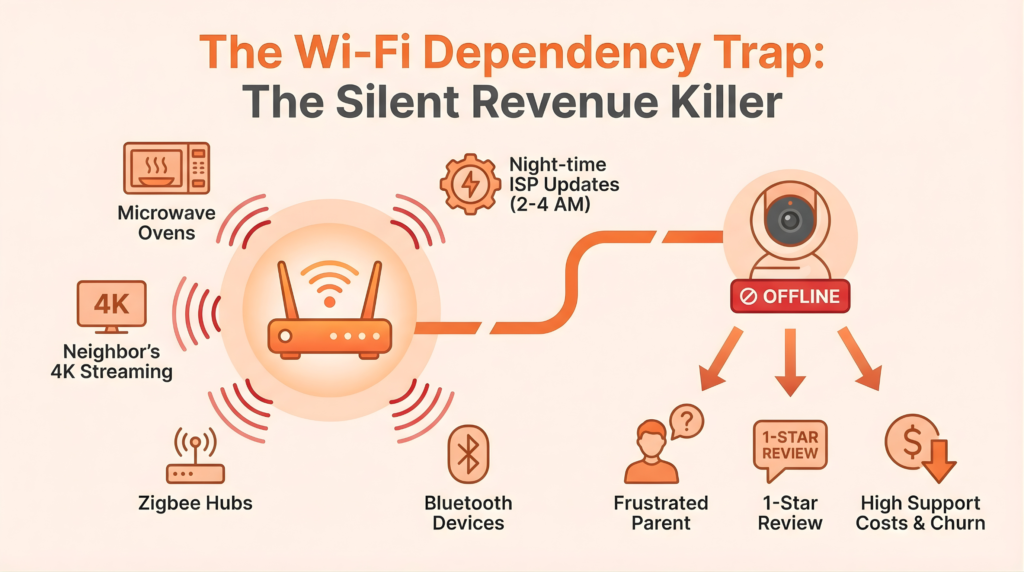
The result is a perfect storm of Wi-Fi-driven baby monitor failures:
- 2.4 GHz congestion: In dense apartment buildings, only three non-overlapping channels exist. A single neighbor streaming 4K video can raise the noise floor enough to stall the upstream feed from your baby monitor.
- 2.4 vs 5 GHz incompatibility: Many routers now default to 5 GHz SSIDs, while Owlet and similar devices still require 2.4 GHz. Parents hit setup dead-ends, and support docs resort to walking them through splitting bands, renaming SSIDs, and rebooting routers—just to get online.
- Mesh network handoff failures:
Static devices, like a wall-mounted baby monitor, often cling to the wrong mesh node (“sticky client” behavior). The home network may look “up,” but the camera’s signal quality quietly deteriorates. - Endless support overhead:
Because Wi-Fi is outside the monitor brand’s control, support teams spend huge amounts of time guiding customers through router diagnostics, resets, and incompatibility issues. - Spectrum saturation from household devices:
Microwaves emit interference that overlaps with 2.4 GHz Wi-Fi. Heating a bottle can obliterate the monitor’s signal-to-noise ratio—causing a dropout at the worst possible moment. - Night-time router updates:
ISPs often push firmware updates between 2:00 and 4:00 a.m. A 15-minute reboot window can be catastrophic if a parent wakes up to “Camera offline” instead of a live feed.
To a networking engineer, all of this is predictable.
To a sleep-deprived parent, it feels like a catastrophic and unforgivable failure of the baby monitor itself.
And these technical issues have real financial consequences: support teams routinely spend 20+ minutes per ticket troubleshooting a customer’s home router—a variable the brand can’t control yet must shoulder the cost for.
Most premium baby monitor brands still rely on unstable home Wi-Fi while selling “sleep insights” subscriptions on top of that weak foundation. When connectivity drops, so does subscription value. Parents do not blame their router — they blame the monitor.
Performance Comparison: Wi-Fi Only vs. Cellular Hybrid Baby Monitors
| Metric | Wi-Fi only baby monitor | Cellular hybrid baby monitor (target) |
|---|---|---|
| Avg support handle time | 20 plus minutes | Under 8 minutes |
| Root cause controllable by OEM | Under 30 percent | Over 80 percent |
| No fault found returns | High | Low |
| NPS volatility | High | Medium |
| Brand trust after one outage | Structural damage | Minor complaint |
| User Satisfaction | Volatile (Dependent on user’s router) | Stable (Dependent on carrier SLAs) |
| Setup Friction | High (SSID entry, pairing failures) | Zero (Pre-provisioned connectivity out of box) |
Most of this is driven by one fact: when support cannot see or control the network, each ticket gets longer, more emotional and more expensive.
The right question is not “How do we debug Wi Fi better” but “How do we remove Wi Fi from the critical path of the baby monitor promise?”
Why Baby Monitor Subscriptions Struggle and What Actually Works
Most baby monitor subscriptions fail because they charge for features parents feel they already own. Sleep graphs, tips, and milestones are helpful, but not essential.
Key reasons include:
- Churn with age: Once the child sleeps reliably, many families cancel or downgrade the subscription, keeping the monitor as a simple camera. Reviews show cancellations around 12 to 18 months.
- Perceived as premium, not essential: Sleep tips and milestones are “nice to have,” not mission-critical.
- Connectivity remains outside the paywall: The core failure mode, Wi-Fi outages, affects all users regardless of subscription.
Miku is a cautionary tale. After a change in ownership, previously included breathing and monitoring features were moved behind a paywall, and firmware updates reportedly degraded devices for non-subscribers. Parents saw this as “charging rent” on hardware they already owned, sparking widespread backlash.
Home security brands have already solved this problem. Companies like SimpliSafe, Ring, and ADT charge monthly fees for professional monitoring and emphasize features such as cellular backup, which keeps alarms online even when Wi-Fi or power fails.
They succeed because they charge for infrastructure, not features. Parents understand the value of a paid cellular backup—it provides a real, ongoing benefit and clear peace of mind when Wi-Fi goes down.
The strongest recurring revenue in the baby monitor market isn’t about adding features— it’s about reliable, always-on connectivity that parents can trust.
- Stop charging for “nice-to-have” insights.
- Start monetizing the connectivity layer that keeps children safe.
Parents pay for peace of mind, not for extra bells and whistles.
Reframing the Product: From Camera to “Always-On Safety Service”
To build a real subscription business, you need to design a cellular baby monitor experience where the paid tier is the only credible way to fully deliver the promise you already market: “I can always see and hear my baby.”
The Target Experience for a Cellular Baby Monitor
A truly modern baby monitor should behave like this:
- Default to Wi-Fi when healthy: The device streams full HD video and rich audio over the home network at zero additional cellular cost.
- Continuous quality monitoring: The monitor tracks packet loss, latency, and jitter between the nursery and the cloud. When metrics indicate Wi-Fi is unreliable, it switches to a failover mode.
- Instant cellular failover: An embedded eSIM in a multi-carrier IoT modem attaches to the best available LTE/4G/5G network and switches the device into a low-data, high-assurance mode.
- Audio first with smart visuals: On cellular the stream prioritizes audio and sends low-frequency stills or short video snapshots on motion so parents can confirm position without burning data.
- Clear, reassuring UX: The app communicates status plainly, for example: “Wi-Fi dropped. Your monitor is now on secure cellular backup. Audio first to preserve battery and data.”
- Optional air-gapped security mode: Offer a “cellular only” mode where the monitor never joins the home LAN, addressing parents who want maximum isolation from home network risks.
Audio-First: The Key to Economical Baby Monitor Connectivity
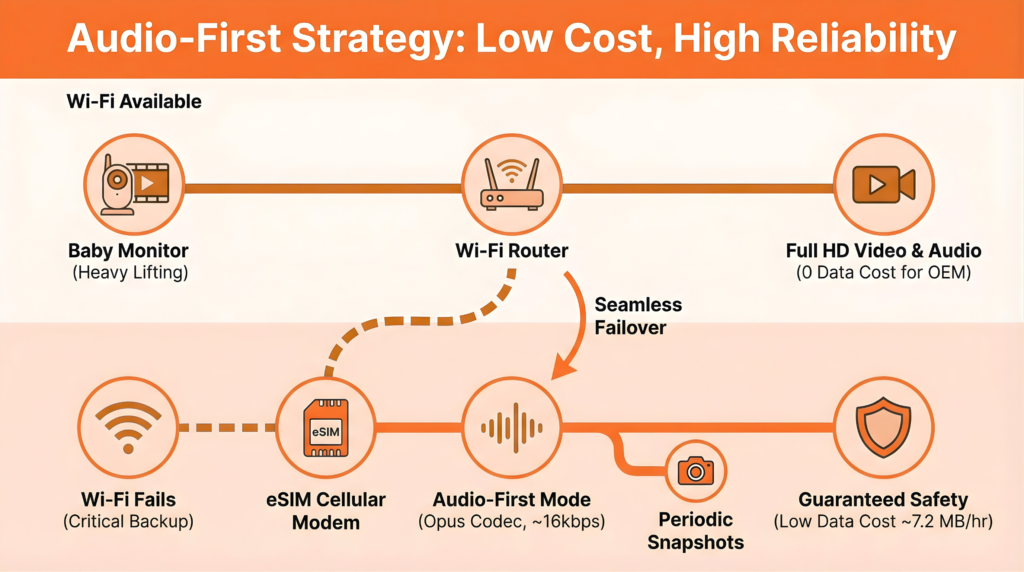
The main cost driver in any cellular baby monitor strategy is video bandwidth. Continuous 1080p video can consume 2–4 GB per hour. At typical IoT wholesale rates, supporting that at $10–$20 per month while maintaining margin is simply not feasible.
The Solution: Audio-First Streaming with Periodic Snapshots
- Efficient audio streaming: Use a low-bitrate codec like Opus at ~16 kbps. For a baby monitor, this is sufficient to clearly capture crying, coughing, and background sounds.
- Low data usage: At 16 kbps, audio consumes about 7.2 MB per hour. A 10-hour night totals just 72 MB, far less than multiple gigabytes.
- Visual confirmation: Periodic still images (every 10–15 seconds, or triggered by motion) give parents a visual check without the cost of continuous video streaming.
This audio-first approach dramatically reduces cellular data requirements while keeping parents informed and babies safe.
Now you have a smart baby monitor connectivity model where:
- Wi Fi handles the heavy video lifting when available.
- Cellular handles the critical audio loop and lightweight visuals in rare outage windows.
- Data costs stay low enough to support high margin subscriptions.
Advantages of eSIM for baby monitors
- Lower total cost of ownership. Industry analyses, including white papers from vendors like Quectel, report lifecycle connectivity savings when using eSIM versus physical SIMs.
- Mature IoT ecosystem. The eSIM market is growing quickly, enabling over-the-air provisioning, carrier switching, and global reach.
- Simplified logistics. No physical SIM handling, fewer returns for SIM issues, and streamlined inventory and fulfillment.
- Better product UX. Pre-provisioned connectivity reduces friction at first use and improves long-term retention.
Comparison: Wi-Fi vs Single-Carrier Cellular(SIM) vs Multi-Carrier (eSIM)
| Feature | Wi-Fi Only | Single-Carrier Cellular | Multi-Carrier (eSIM) |
|---|---|---|---|
| Connectivity reliability | Low to medium | Medium | High (failover + redundancy) |
| Deployment complexity | Medium (customer setup) | Low (pre-provisioned) | Low (embedded, multi-net) |
| Support cost from connectivity | High | Medium | Low |
| Recurring revenue potential | Moderate (analytics) | Good (data plan) | Excellent (global subscription) |
| SIM / component lifetime cost | N/A | Higher (physical SIM) | Lower (eSIM/ savings) |
The cellular hybrid monitor makes resilience the product. It reframes subscriptions as insurance for a real risk parents care about, enables predictable recurring revenue, and reduces support overhead. That is the practical path from fragile hardware to a resilient subscription business.’
Why Parents Will Pay for Always-On Safety
Shifting from selling hardware to selling guaranteed connectivity fundamentally changes your business model. Parents aren’t paying for sleep graphs—they’re paying for peace of mind. This is a subtle but powerful difference: it turns a passive gadget into an active service that protects what matters most.
By structuring your subscriptions around connectivity, you create clear value differentiation:
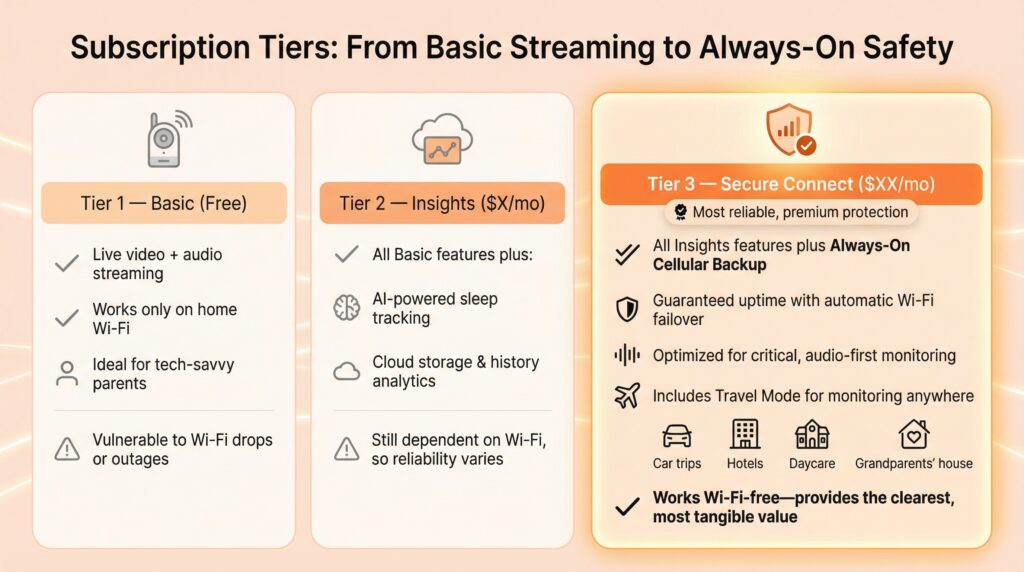
This new model transforms your monitor from a “nice-to-have” luxury to an essential, always-on safety service.
Spenza: “MVNO‑in‑a‑Box” for Baby Monitors
You might be thinking: “We’re a baby‑monitor hardware company — we’re not a telco.” That’s exactly where Spenza comes in. They act as your silent MVNO‑in‑a‑box, handling all the telecom complexity so your team can stay focused on building the best monitoring experience.

Key Capabilities Spenza Brings to Baby Monitor OEMs
- Operator-Neutral Connectivity Marketplace
- Through Spenza, you can source IoT data plans (LTE‑M, 4G, etc.) from many carriers, all via a single platform.
- Their “Unify” layer lets you mix your own network contracts with Spenza-sourced plans, giving you redundancy and flexibility.
- You get full visibility into per-line costs, usage, and margins.
- No-Code Subscription + E-Commerce for Connectivity
- Spenza’s “Grow” offering lets you spin up a branded connectivity storefront (think Shopify-style) without building your own telecom billing engine.
- Parents can activate their cellular plan, upgrade tiers (e.g., from Insights → Secure Connect), add lines (for grandparents), and manage payments — all through your own brand interface.
- Billing, taxation, and telecom compliance are all automated, so you don’t need to build a whole regulatory team.
- Support teams get a single pane of glass to diagnose whether a connectivity issue is due to the device or the network.
- eSIM Orchestration and Management
- Spenza’s orchestration engine lets you remotely provision eSIM profiles, migrate devices to different carrier profiles, and manage the lifecycle of each device globally.
- They support GSMA’s SGP.32 standard, which is critical for scalable, compliant IoT connectivity across different regions.
- This orchestration ensures devices dynamically switch to the most cost-effective, reliable network — improving uptime and reducing data cost.
- Scalable, Compliant Operations
Why This is a Game-Changer for Your Baby Monitor Strategy
- Faster Go-To-Market: You don’t have to become a telecom company — you just embed Spenza’s eSIM and use their backend.
- Brand-Led Customer Experience: Parents interact with your app/storefront, not a third-party carrier portal.
- Operational Efficiency: No need to manage dozens of carrier contracts or SIM inventories.
- Global Ambition Without the Headache: Because Spenza supports multi-carrier, multi-region connectivity, you can scale internationally without reinventing your infrastructure.
- Future-Proofing: With eSIM orchestration and GSMA SGP.32, your devices can evolve, switch profiles, and stay online in new markets reliably.
Why Spenza Is the Fastest Path to a Cellular Baby Monitor Subscription Business
If you tried to do all of this in-house, you’d need to:
- Negotiate multiple carrier contracts in every region you want to operate.
- Build your own MVNO-style platform to manage SIM provisioning, usage, and billing.
- Handle SIM/eSIM logistics, regulatory compliance (KYC, telecom taxes), and invoicing in every country.
For a baby monitor brand whose real IP is in computer vision, user experience, and parenting insights, that’s a huge diversion — and a multi-year project.
Spenza’s job is to take that burden off your plate.
The future category leaders in baby monitors will not just sell cameras. They will sell always-on, cellular-backed safety services powered by operator-neutral platforms like Spenza.
Conclusion: Turning Connectivity into Competitive Advantage
The era of Wi-Fi-only baby monitors is ending. Smart brands that embrace always-on cellular connectivity can transform reliability into a core competitive advantage, providing parents with continuous peace of mind they can trust.
By leveraging Spenza for eSIM orchestration, multi-carrier failover, and subscription management, fragile hardware becomes a premium safety service rather than just a gadget.
This approach reduces support costs, ensures consistent performance, and creates a scalable path to predictable recurring revenue. Brands that make connectivity the foundation of their offering will not only deepen customer loyalty but also define the next generation of smart baby monitoring, where safety, reliability, and trust are built in from the start.
FAQs
Spenza provides a turnkey, no-code platform that allows hardware brands to become MVNOs without building telecom infrastructure. Spenza handles carrier aggregation, eSIM management, billing, and tax compliance, allowing brands to launch a branded connectivity marketplace in as little as 7 days.
Turn connectivity into your next revenue stream. Book your demo and see the full Spenza platform in action.’

